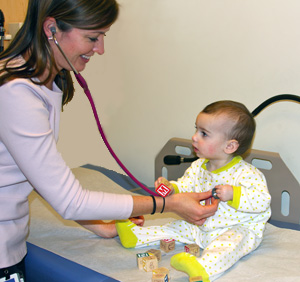CDGEMM Study
The Celiac Disease Genomic Environmental Microbiome & Metabolomic Study follows infants from birth through childhood to learn more about each of the many factors that contribute to the development of celiac disease.

Celiac disease (CD) is a complex disease caused by eating gluten (a protein contained in the cereals wheat, rye and barley). It affects about 1% of the population worldwide.
In people with CD, the ingestion of gluten causes damage to the intestines and a diverse variety of symptoms. Classic symptoms of CD include chronic diarrhea, weight loss and poor nutrition. However, many people with celiac disease may have other symptoms like fatigue, constipation or no symptoms at all. Currently, the only treatment for CD is removal of gluten from the diet. Some gluten-free cereals are easily available, like corn and rice, but the replacement of foods like bread, pasta and baked goods with gluten-free alternatives can be expensive. This increases the difficulty of following a gluten-free diet over a lifetime. For this reason, doctors and scientists are extremely interested in finding other treatments or ways to prevent the onset of CD.
To develop CD you must eat gluten and have the specific genes HLA-DQ2 and/or DQ8. Genes are passed from parent to child, and therefore members of the same family have many genes in common. The chance of developing CD is much higher (between 8 and 15%) for people who have a family member that is already affected. Because CD shares the same genetic basis as many other diseases, people with other autoimmune diseases, such Type 1 Diabetes (T1D), are also more likely to get CD as compared to the general population.
Want to learn more about CD? We suggest visiting these websites:

